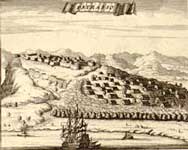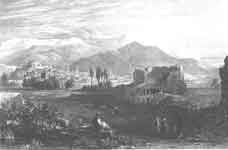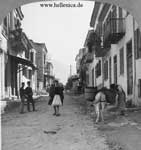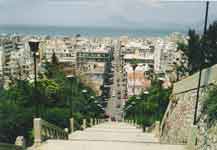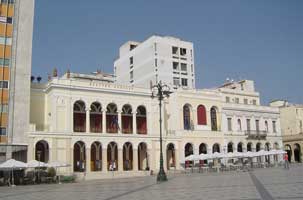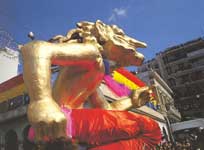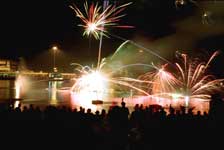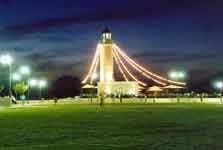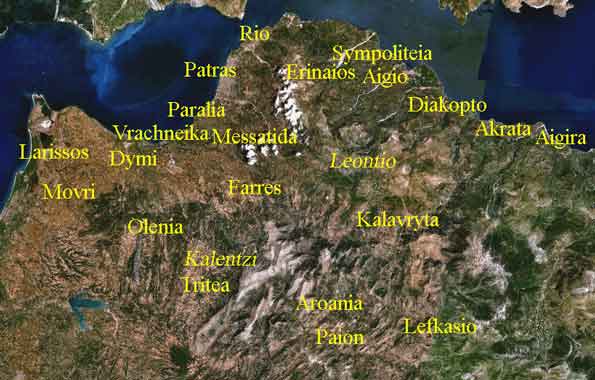Administrative Region : West Greece
Regional unit : Achaia
Patra or Patras (Modern Greek: Πάτρα, Pátra, [ˈpatra], Classical Greek and Katharevousa: Πάτραι, Pátrai (plural), Latin: Patrae (plural)) is Greece's third largest urban area and the regional capital of West Greece, located in northern Peloponnese, 215 kilometers west of Athens. The city is built at the foothills of Mount Panachaikon, overlooking the Gulf of Patras.
The Patras Metropolitan Area is a conurbation of 222,460 inhabitants,[1] while its urban area, contained within the Patras municipality, had a population of 202,757 (in 2001). The core settlement has a history spanning four millennia. In the Roman period it had become a cosmopolitan centre of the eastern Mediterranean whilst, according to Christian tradition, it was also the place of Saint Andrew's martyrdom.
Dubbed Greece's Gate to the West, Patras is a commercial hub, while its busy port is a nodal point for trade and communication with Italy and the rest of Western Europe. The city has two public universities and one Technological Institute, hosting a large student population and rendering Patras a major scientific centre with a field of excellence in technological education. The Rio-Antirio bridge connects Patras' easternmost suburb of Rio to the town of Antirrio, connecting the Peloponnese peninsula with mainland Greece.
Every year, in February, the city hosts one of Europe's largest and most colourful carnivals; notable features of the Patras Carnival include its mammoth-sized satirical floats and extravagant balls and parades, enjoyed by hundreds of thousands of visitors in a pleasant Mediterranean climate, with relatively cool yet humid summers and rather mild winters. Patras is also famous for supporting an indigenous cultural scene active mainly in the performing arts and modern urban literature; it was European Capital of Culture 2006.
Geography and climate
Satellite view of Patras.
Patras is located 215 km (134 mi) west of Athens by road, 94 km (58 mi) northeast of Pyrgos, 7 km (4 mi) south of Rio, 134 km (83 mi) west of Corinth, 77 kilometers northwest of Kalavryta, and 144 km (89 mi) northwest of Tripoli.
A central feature of the urban geography of Patras is its division in upper and lower sections, connected with stairs. This is the result of an interplay between natural geography and human settlement patterns; the lower section of the city (Kato Poli), which includes the 19th century urban core and the port, is adjacent to the sea and stretches between the estuaries of the rivers of Glafkos and Haradros. It is built on what was originally a bed of river soils and dried-up swamps. The older upper section (Ano Poli) covers the area of the pre-modern settlement, around the Fortress, on what is the last elevation of Mount Panachaikon (1,926 m (6,319 ft))[2] before the Gulf of Patras.
A view of Panachaiko mountain.
Hydrology
The largest river in the area is Glafkos flowing to the south of Patras. Glafkos springs in Mount Panachaikon and its water is, since 1925, collected in a small mountainous reservoir-dam near the village of Souli and subsequently pumped in order to provide energy for the country's first hydroelectric plant.[3] The water is also used for the orchards of Eglykas and as drinking water for the city. Other rivers are Haradros, Meilichos and the mountain torrent Diakoniaris.
Climate
Source: HNMS (ΕΜΥ)[4]
Imperial conversion
Patras has a Mediterranean climate. It features the typical mild, wet winters and hot, dry summers, with spring and autumn being pleasant transitional seasons. Autumn in Patras however is wetter than spring.
Fauna and Flora
Of great importance for the biological diversity of the area and the preservation of its climate is the swamp of Agyia, a small and coastal aquatic ecosystem of only 30 hectares, located to the north of the city centre. The main features of this wetland are its apparent survival difficulty, being at the heart of a densely populated urban centre that features a relatively arid climate and its admittedly high level of biodiversity, with over 90 species of birds being observed until the early 1990s, according to a study by the Patras Bureau of the Hellenic Ornithological Society.[5]
Seismic activity
Another geophysical characteristic of the region is its high level of seismicity. Small tremors are recorded along the coast of Patras almost constantly. Larger earthquakes hit the area every few years with potentially destructive effects. In 1993, a 5.0 magnitude earthquake caused some damage to several (mostly older) buildings throughout Patras due to the proximity of the epicenter to the city. On June 15, 1995, a 6.2 magnitude earthquake hit the nearby town of Aigion, causing some structural damage to a few buildings of Patras as well. The Ionian Islands are also frequently hit by even more severe earthquakes, some of which can be felt in the city. In antiquity, the most notable example of destruction caused by an earthquake in the region was the total submergence of the ancient Achaean city of Helike, now Eliki.
History
Main article: History of Patras
The Roman Odeon.
Inside the reconstructed odeon.
View of King George I Square in the late 19th century.
Monument for the Greek War of Independence (1821–1830); Agiou Georgiou Square.
Antiquity

Marsyas Bronze from Patras British Museum 269
The first traces of settlement in Patras date as early as in the 3rd millennium BC, in the area of modern Aroe. Patras flourished for the first time during the Post-Helladic or Mycenean period (1580–1100 BC). Ancient Patras was formed by the unification of three Mycenaean villages located in modern Aroe; namely Antheia and Mesatis. Mythology has it that after the Dorian invasion, a group of Achaea from Laconia led by the eponymous Patreus established a colony. During antiquity, Patras remained a farming city. It would be in Roman times that it was to become an important port.

After 280 BC and prior to the Roman occupation of Greece, Patras played a significant role in the foundation of the second "Achaean League" (Achaiki Sympoliteia), along with the cities of Dyme, Triteia and Pharai. Later on, and following the Roman occupation of Greece in 146 BC, Patras played a key role, and Augustus founded a Roman colony in its area. Moreover, Patras became a Christian centre since the early days of Christianity, and it is the city where St. Andrew was crucified.
Middle Ages
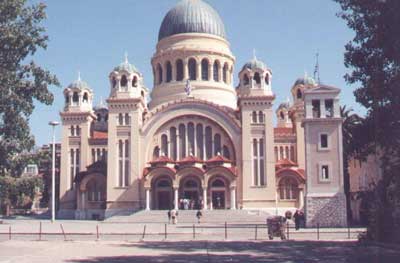
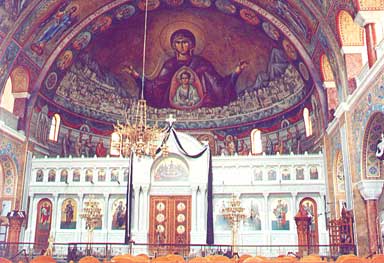
Agios Andreas (Saint Andrew), Patra, Right (Interior) NL Wikipedia [ Source : L , R]
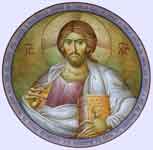
Central dome of the cathedral Agios Andreas (Saint Andrew) in Patras
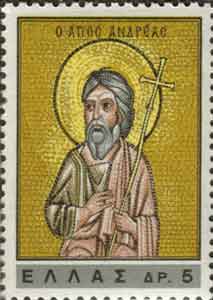
Agios Andreas
During Byzantine times Patras continued to be an important port as well as an industrial centre. One of the most scholarly philosophers and theologians of the time, Arethas of Caesarea was born at Patrae, at around 860. By the 9th century there are strong signs the city was prosperous: the widow Danielis from Patras had accumulated immense wealth in land ownership, the carpet and textile industry, and offered critical support in the ascent of Basil I the Macedonian to the Byzantine throne.
In 1204 Patras was conquered by the Fourth Crusade, and became the seat of the Latin Duchy of Athens within the Principality of Achaea. Captured in 1205 by William of Champlitte and Villehardouin, the city became a part of the principality of Achaea, and its archbishop primate of the principality while in 1387 Juan Fernández de Heredia, grand master of the order of the Knights Hospitaller at Rhodes, endeavoured to make himself master of Achaea and took Patras by storm. In 1408, Patras became Venetian, and by the close of the 15th century the city was governed by the archbishop in the name of the pope. It was nevertheless seized and recaptured once more in 1430, by the Despotate of Morea and its despot Constantine Palaiologos, who succeeded in recapturing almost the whole of Morea, apart from Venetian possessions. The administration of Patras was appointed to George Sphrantzes, while Constantine was immediately contested by the Ottoman Empire and later, in 1449, became emperor of the Byzantine Empire.[6]

Patras remained a part of the Despotate of Morea until 1458, when it was conquered by the Sultan of the Ottoman Empire, Mehmet II. Under the Ottomans, it was known as Baliabadra, from the Greek Παλαιά Πάτρα, as opposed to Νέα Πάτρα, the town of Ypati in Central Greece. Though Mehmet granted the city special privileges and tax reductions, it never became a major centre of commerce. Venice and Genoa attacked and captured it several times during the 15th and 16th centuries, but never re-established their rule effectively except Venetian rule between 1687–1715.[7]
Modern Era
|
|
|
|
|
|
Patras was one of the first cities, in which the Greek Revolution began in 1821;[8] but the Turks, confined to the citadel, held out until 1828. The city was liberated on 7 October 1828 by the French expeditionary force in the Peloponnese, under the command of General Maison. Patras developed quickly into the second largest urban centre in late 19th century Greece.[9] The city benefited from its role as the main export port for the agricultural produce of the Peloponnese.[10]
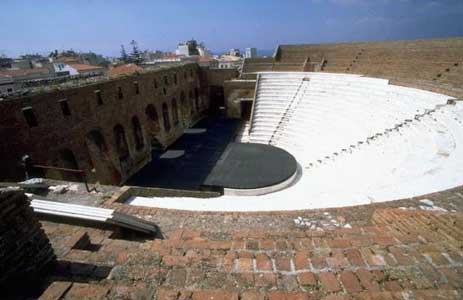
The Roman Odeon (Odeion) of Patras, second century AD, marble seats added the last century. [Source]
In the early 20th century, Patras developed fast and became the first Greek city to introduce public streetlights and electrified tramways.[11] The war effort necessitated by the first World War hampered the city's development and also created uncontrollable urban sprawl with the influx of refugees from Asia Minor. During the Second World War, the city was a major target of Italian air raids; during the period of Axis occupation, a German military command was established and German and Italian troops stationed in the city. After the liberation in October 1944, the city grew fast to recover, but in later years was increasingly overshadowed by the urban pole of Athens.
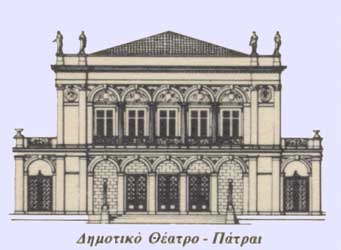 |
The Municipal Theatre of Patras "Apollon", 1872 , plan by Ernst Ziller in Plateia Georgiou A |
Urban landscape
Patras' western seafront.
The city is divided into the upper and the lower section, connected with roads and broad stairs. The upper section (Ano Poli) is the older and the more picturesque; however, the lower section (Kato Poli) is attractively laid out, according to the 1858 city plan, featuring a variety of squares. The most notable of these are the Psila Alonia and the Georgiou I Square . A number of exquisite neoclassical buildings are to be found, including the Apollon Theatre in Georgiou I Square, the Town Hall, the headquarters of the Local Trade Association and the Court of Justice. A replica of the city's emblematic old lighthouse - which was situated at the dock of Saint Nikolaos - rises at the end of Trion Navarhon street, near the temple of Saint Andreas.
Panoramic view of Patras at Night.
In general, much of Patras' coastline is framed by roads and avenues running alongside; these include Dymaion Coast to the south and Iroon Polytechneiou Road to the north. Unfortunately, due to insufficient urban planning as well as institutional weaknesses on behalf of the City Council (mainly due to a lack of proper financial planning), some of the city's coastal areas are not in an ideal condition, with several areas illegally occupied by shops built along the coastline. This is contrary to what the Constitution of Greece of 2001 declares; that the Greek coastline is a "national treasure", and as such belongs to the Greek people.
Patra Carnival, Click images to enlarge
Landmarks
The dome of Ayios Andreas' church.
View of the city from the stairs of Agios Nikolaos street.
The entrance of the new Archaeological Museum of Patras.
King George square in Patra.
Old mansion of Psilalonia square.
Patras and its region is home to various Ancient Greek, Roman and Byzantine Monuments, including the Roman Odeon, the Fortress of Rio and the Fortress (castle) of Patras.[12] More specifically the main sights of the city are:
The Roman Odeon, the most significant ancient monument, is situated in the upper town and was built around 160 AD, during the reign of either Antoninus Pius or Marcus Aurelius. It has been restored and partially reconstructed and it is used as an open-air theatre for performances and concerts during summer months.
The medieval Patras Castle, in the location of the ancient acropolis overlooking city, was initially built in the 6th century AD from the Byzantine emperor Justinian, having many additions from the period of the Frankish and Venetian rule of the city, as long as from the time of the Despotate of Morea and the years of the Ottoman Empire. Its current outline dates back to the second Venetian rule of the town (1687–1715). Today, its interior is used as a public garden.
The Roman Amphitheatre, situated near the Roman Odeon, in Ifestou street, is one of the most important and impressive monuments of the city. It is dated in the dues of the 1st century AD, at a period of the biggest development of Roman Patras. Its area has been only partly excavated.[13]
The monumental church of Saint Andrew of Patras was founded in 1908 by king George I and was inaugurated in 1974. It is dedicated to Saint Andrew, the patron of the city and is situated near the seafront, between the areas of the new and the old port.[14] It is the second largest temple of byzantine style in the Balkans (after the Cathedral of Saint Sava in Belgrade). The central cupola is 46 metres tall and is the base for a 5-metre gold-plated cross and twelve smaller ones, symbolizing Christ and the twelve apostles. A congregation of at least 5,000 can attend sermon within the church.[15]
The municipal Theatre Apollon, built in 1872 after plans by the German architect Ernst Ziller. The building is characteristic of the 19th century neoclassical style and is located in the central square of the city.
The Achaia Clauss wine industry and tasting center, which is located on the outskirts in Petroto village. It was founded in 1861 by the Bavarian Gustav Clauss and is most famous for its Mavrodaphne.
The Patras Archaeological Museum, which exhibits the history of Patras from the prehistoric era to the late Roman times. The exhibition is divided into three thematic sections which are demonstrated in the big three separate halls of the museum: the Chamber of Private Life, the Hall of Necropolis and the Hall of
|
|
|
|
Public Life.
The remains of the Roman Aqueduct, which connected the acropolis with the springs of Romanos. The aqueduct measured 6.5 km (4.04 mi) from the water cistern to the castle. For the greater part of this distance, the water passed through a man-built underground pipe, over passing valleys and gorges on carefully constructed archways, parts of which remain standing to this day, in the area of Aroi.[16]
The Roman bridge over the river Milichos, which dates from 114 AD. It is situated in Agyia, in the northernn suburbs of the city, at the junction of Aretha street and the National Road.
The Turkish baths' building (16th century), in Boukaouri street, which still retains its initial use. It is one of the few Turkish baths surviving in Europe.
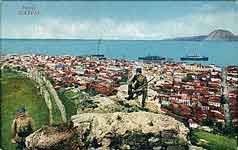 |
 |
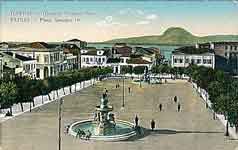 |
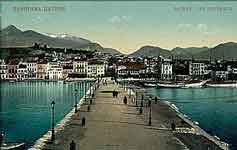 |
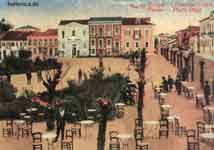
Patra, Olga Place (Plateia Olgas)
Parks and Squares
Georgiou I Square, the central square and the heart of the city. Its was named after king George I. The square's fountains were installed in 1875 at a cost of 70,000 drachmas each, a huge amount for the finances of Greece and Patra at the time. It was and continues to be the center of political and cultural happenings, the venue that hosts all significant activities, political gatherings, rallies, cultural events and most importantly, the square were Carnival-related events take place.
Ethnikis Antistaseos Square (Olga's Square). It is know by the name of queen Olga, wife of king George I. It was planted with trees and called "The queen's garden". Today the square is officially called Ethnikis Antistaseos, but its old name (Olga's Square) is the one that is still in use by the citizens of Patras.
Trion Symmahon Square. It bears the name of the Three Allied Powers who fought for the liberation of Greece. These forces were England, France and Russia. The square features a flower clock and links the Ayiou Nikolaou pedestrian way with the seaside front and the dock of Ayios Nikolaos.
Psilalonia Square (Greek: Ψηλαλώνια or formally Πλατεία Υψηλών Αλωνίων) is one of Patras's most popular squares. It is located 1.5 km from downtown Patras, next to the city's main north-south street, Gounari Street. It features a fountain, many sidewalks, palm trees and playgrounds. A bronze statue of Germanos of Patras stands on the northern end, while a memorial plaque to people executed during the Axis occupation of Greece stands on the south-western corner. It is surrounded by several shops, restaurants and cafes and many modernist buildings. It was completed in the mid to late-19th century, when trees were added, along with neoclassical buildings. After World War II and the Greek Civil War however, and through the 1960s and 1970s, most neoclassical buildings were replaced by eight-story residential buildings. In the west end, a 15 m (49.21 ft) tall cliff overlooks the Trion Navarchon pedestrian street, and offers a wide vista across the western Gulf of Patras, including the mountains of Aitoloakarnania.
The Spinney of Patras (Greek: Δασύλλιο), is situated in a pine-tree-covered hill, which is dubbed "the Gulf of Patras' veranda" due to the panoramic view it offers. The spinney is ideal for recreational walks and jogging, with its specially formed paths and the shade offered by the tall trees. The pine trees that cover the spinney were planted in March 1916 by students of Patras' Primary Schools under the supervision of Austrian forest specialist Steggel.
Architecture
Kolokotroni street in central Patras.
The city is endowed with a number of neoclassical buildings and mansions dating from the late 19th and early 20th centuries. In the past, years of neglect and the absence of protection enforcement, as well as recent earthquakes had contributed to the destruction of several such examples. Today, however, most surviving neoclassical buildings are under a strict protection status. As a part of the 2006 European Capital of Culture programmme, there was a project for the restoration of the city's architectural heritage.
Patras' center is characterized by a composition of architectural currents and trends. Α representative example, are the façades around the central square of the city (Georgiou I square). The neoclassical Apollo Theatre, a work of Ernst Ziller is situated next to the modernist building of the Hall of Literature and Art (Μέγαρο Λόγου και Τέχνης), while the majority of the unattractive multi-storey buildings on the west and south side of the square were constructed in the late '60s and the '70s.
Today's Patra is a relatively new-built city, as its medieval constructions were completely destroyed during the Greek War of Independence. The oldest surviving buildings (apart from ancient monuments and the castle) are the church of Pantocrator in Ano Poli and a residential building at the corner of Ayiou Nikolaou and Mezonos street, built in 1832. The area on the south of the castle, around the Roman Odeon and the church of Pantokrator, in the Upper Town (Ano Poli), is the most appealing of the city, as it is the only one in which the height of constructions is limited to two-storey buildings. [17]
City plan
The first city plan of Patras, 1829.
Patras city districts.
Patras is the first city of the modern Greek state to develop a city plan. In January 1829, Stamatis Voulgaris, a Greek engineer of the French army, presented the plan of the new city of Patras to the Governor Kapodistrias, who approved it. Voulgaris applied the orthogonal rule in the urban complex of Patras. The plan was divided into two sectors, the upper and the lower city, with a different city block layout; a revision of the proposal in 1858 was that finally realised.
Districts and neighbourhoods
Main article: List of neighbourhoods in Patras
Nowadays, the municipal units of Rio, Paralia, Messatida and Vrachnaiika have functionally become a part of the wider urban complex of Patras. Apart from the city center, the main districts of Patras are:
Patras municipal unit:
Agyia (north)
Agia Sofia (north)
Anthoupoli (north)
Aroi (east)
Begoulaki (south)
Bozaitika (north)
Eglykada (east)
Gouva (north)
Ities (south)
Koukouli (east)
Neo Souli (east)
Perivola (east)
Prosfygika (east)
Psarofai (east)
Tabachana (east)
Zarouchleika (south)
Zavlani (north)
Rio municipal unit:
Agios Georgios Riou
Agios Vasileios
Aktaio
Arachovitika
Kastritsi
Psathopyrgos
Paralia:
Paralia
Mintilogli
Roitika
Messatida:
Ovrya
Kallithea
Petroto
Saravali
Vrachneika:
Vrachnaiika
Kaminia
Monodendri
Tsoukaleika
Government
Patras is the regional capital of Western Greece and the capital of the Achaea peripheral unit. Since 2011, the city is also the capital of the administrative division, which includes (along with Western Greece) the peripheries of Peloponnese and the Ionian Islands.
Municipality
Patras municipal units within the peripheral unit of Achaea.
The current municipality Patras was formed at the 2011 local government reform by the merger of 5 municipalities situated in the urban area of the city. These former municipalities, which became municipal units, are: (in parenthesis their population, 2001)[18]
Messatida (12,246)
Paralia (9,153)
Patras (171,616)
Rio (12,674)
Vrachnaiika (4,805)
Demographics
Historical Population[19][20][21]
Year Patras Urban Area
1853 15,854 19,499
1861 18,342 23,020
1870 16,641 26,190
1879 25,494 34,227
1889 33,529 44,970
1896 37,985 51,932
1907 37,728 -
1920 52,174 -
1928 61,278 -
1951 87,570 94,192
1961 96,100 103,985
1971 112,228 120,847
1981 142,163 154,596
1991 161,782 190,463
2001 171,616 210,494
2007 (est.) 180,000 230,000
Population of Patras (dark blue) and urban area of Patras (blue) from 1853 to 2007.
Patras Municipality within the periphery of Western Greece
Consulates
The city hosts consulates from several European countries (the only exception is the Lebanon consulate)
United Kingdom British Honorary Vice Consulate
Austria Consulate of Austria
France Consulate of France
Belgium Consulate of Belgium
Germany Consulate of Germany
Sweden Consulate of Sweden
Switzerland Consulate of Switzerland
Estonia Honorary Consulate of Estonia
Finland Honorary Consulate of Finland
Italy Honorary Consulate of Italy
Lebanon Honorary Consulate of Lebanon
Poland Honorary Consulate of Poland
Netherlands Honorary Consulate of Netherlands
Denmark Royal Danish Consulate
Norway Royal Norwegian Honorary Consulate
Infrastructure
Patras port.
View of the port.
Rio-Antirio bridge.
In the past, Patras lacked public investment in infrastructure; in recent years, this trend has changed significantly. Several important works have been recently completed to serve Patras as an Olympic city, a European capital of culture and one of the most populous Greek cities.
The city has always been a sea-trade hub due to its strategic position. The port manages more than half of the foreign sea-passenger transportation in Greece,[22] and has excellent car-ferry links with the Ionian islands and the major Adriatic ports of Italy. Additionally, a new port is under construction in the southern section of the city to accommodate the increased traffic and relieve the city centre from port operations.[23]
A newly constructed, 20 km (12 mi) ring road (the Bypass of Patras) was first opened in 2002 in order to alleviate heavy traffic throughout the city.[24] A mini ring road (known as the "Mini bypass" of Patras) is now being constructed to alleviate heavy traffic-related problems in the city centre.[25] Two large highways are under construction that will connect the seacoast and the new port with the Bypass of Patras. The first is over the small Diakoniaris river (from Eleftheriou Venizelou street until the Bypass'es exit in Eglykada), while the second consists of two roads, 4 km (2 mi) each, that will run in parallel with the Glafkos river.[26][27] Another project will lead to an additional entrance to the downtown area by expanding Kanakari street.
The highway connection with Athens and Pyrgos is to be drastically upgraded.[28] Patras will also be the central hub of the Ionia Odos highway, intended to bridge western Greece from Kalamata to Ioannina. The Rio-Antirio bridge is located to the north of the city and links Peloponnese to mainland Greece, and was completed in August 2004.
In 2011, the new harbour (southern port) went into operations. Ferries to Italy now dock there.[29]
A rudimentary single, narrow gauge railway track crosses the city and connects it to Athens and to Pyrgos-Kalamata, while the central passenger train station lies to the west of the downtown area, between Aghiou Nikolaou Street and Othonos-Amalias Avenue. The main freight station of Aghios Andreas lies further to the south, next to the homonymous church. Finally, the old depot of Aghios Dionysios, consisting of about ten tracks, offers basic turntable and roundhouse facilities; its length is approximately 400 m (1,312.34 ft). A new standard gauge railway to Korinth and further to Athens is under construction.
Other heavy infrastructure works include the Peiros-Parapeiros dam (to provide water supply for Patras and surrounding towns)[30] and a "small industries" park that will be constructed next to the Glaykos river and provide an easy connection with the new port.
The city is one of the main Greek internet and GRNET hubs and is connected with high speed lines to Athens as part of the backbone. A metropolitan optical network will be deployed in the city, with a total length of 48 km (30 mi).[31]
Two major state hospitals operate in the city: the Saint Andreas Hospital is the oldest of the two; named after the city's patron saint. The University Hospital of Rio is a prominent university hospital, where intern medical students specialize on their major. There exist, in addition, two smaller state hospitals, Karamandanio - children's hospital, and the Center of Chest Diseases of Southwest Greece, and the Greek army operates the 409 army hospital in the city. A large range of private hospitals and clinics operate in parallel.
Numerous art venues[32] and an ultra-modern archaeological museum[33] were constructed for the needs of European Culture Capital designation. The cultural and educational facilities include the Municipal Library, the university libraries, many theatres, the municipal art gallery,[34] the University of Patras's facilities, the Hellenic Open University and the Technical Institute of Patras. A number of research facilities also are established in the university campus area.
Economy
Main articles: Economy of Greece and Tourism in Greece
The economy of the city largely depends on a thriving service sector. Its main economic activities include retailing, logistics, financial and the public sector services. Patras suffered a severe problem of deindustrialization during the late 1980s and 1990s; a number of major productive units shut down in successive order. As a result, a considerable portion of the city's workforce and the city's economic planning in its entirety had to be re-evaluated and restructured by the authorities. The University of Patras contributed by working towards this goal, using its widely respected service and technology sectors. The area still retains some of its traditional winemaking and foodstuff industries as well as a small agricultural sector, and its industrial area lies approximately 20 km to the south of the downtown area, located between the 16th km of GR-9 and Fares/Phares (pro. FAH-rehs). Major businesses in Patras include:
Tertiary education
The University of Patras with the Rio-Antirio bridge in the background.
The city is home to three major educational institutions: the University of Patras, the Hellenic Open University and the TEI of Patras.
Banking
Most Greek Banks have their regional headquarters for Western Greece located in Patras.
Construction and real estate
Numerous small local companies are involved in the construction sector.
Retailing
Most of the large retail and super-market chains operate in the city. Patras has also some local but dynamic companies.
Tourism
In 2010, the new Infocenter of Patras was established, inside the neoclassical building of the former market "Agora Argyri", in Ayiou Andreou street. The building includes a conference hall, along with multi-purpose and exhibitional spaces.[35] The prefecture of Achaia has approximately 4,800 hotels rooms and in 2006, 286,000 tourists, mainly from Greece, stayed in the area for a total of 634,000 days.[36][37]
Manufacturing
Titan Cement Company operates a large cement factory, with a private port, in Psathopyrgos, a suburb of Patras.
Energy
View of the wind park on Panachaiko mountain.
Acciona has recently completed the largest wind park in Greece, on the Panachaiko mountain, overlooking the city of Patras.[38] The Public Electric Company, operates a small hydroelectric plant on river Glafkos.[39]
Foodstuff
Tentura liquer from Patras.
Inside the Achaia Clauss wine factory, founded in 1861 by Gustav Clauss, famous for its Mavrodaphne.
Some of the biggest industries in the city belong to the soft drinks and drinks sector. There are factories from Coca Cola HBC and Athenian Brewery established in area, along with the facilities of the largest local company in soft-drinks production, Loux (ΛΟΥΞ). The city is also home to many leading Greek wineries and distilleries, among them the venerable Achaia Clauss. In the food sector, Friesland Foods, through the local subsidiary NoyNoy, operates a new yogurt factory in the city's industrial area. Patras is also home to important fish-farming companies (Andromeda, Nireus).[40][41] ECOFEED operates in the industrial zone of Patras, the largest fish-feeds factory in the Mediterranean.[42] The city hosts the second largest flour-mills in Greece, Kepenou-Mills.[43]
Machinery
Patras has several packing and industrial equipment companies. The most important of them are the local Antzoulatos and the multinational Frigoglass, a subsidiary of Coca-Cola, headquartered in the suburbs of Patras. Ideal is a leading bike producer in Greece, with large export activities.
Pharmaceutical
CBL is headquartered in Patras, while Vianex - owned by Pavlos Giannakopoulos - has its largest production facilities in the industrial area of the city.[44]
Textiles
The once omnipresent textile industry of the city is now almost defunct after the shut-down of the huge factory of Peiraiki-Patraiki (Πειραϊκή-Πατραϊκή), followed by numerous smaller textile industries. This had an important impact on the city's economy and resulted in high levels of unemployment during the '90's. The remains of the facilities, still cover hundreds of acres in the south side of the city. Nowadays, Patras companies focus in dress production, the most important amongst them being DUR.
Timber and paper
Patras hosts several timber manufacturing companies, and a wood distribution center of Shelman. The largest local company is Abex.[45] The paper sector is also active including a paper-factory belonging to Georgia-Pacific (Delica) and two important Greek companies, Elite and El-pack, headquartered in the city.
Research
Atmel Corporation has an important R&D facility in Patras with more than 200 employees
Bytemobile has its European Development Center in Patras.[46]
Intracom facilities in Patras house the offices of Telecommunications Software Development, Terminal Equipment Design, Development Programmes, and Support Services divisions. Expansion plans have recently been completed.[47]
CBL Patras, a global manufacturer of specialty chemicals and active pharmaceutical ingredients, is a startup from a professor of the University of Patras
Patras Science Park is an incubator for many small but upcoming technology companies.[48][49]
There has been a significant development in the R&D sector, during the last years, as a result of the many research institutes and the University impact in the area. The Computer Technology Institute and the Industrial Systems Institute[50] of Greece are headquartered in Patras. The city is also a host to the FORTH-ICE-HT (Institute of Chemical Engineering & High Temperature Chemical Processes)[51] and the Institute of Biomedical Technology.[52]
Culture
Apollon Theatre.
Patras Carnival; the float of the "King of the Carnival".
Gerokostopoulou street during the Patras Carnival.
Inside the municipal library.
The cultural activity of Patras includes the Patras International Festival (with various artistic activities, mainly in the fields of theatre and music), the Patras Carnival and the Poetry Symposium.[53]
The city hosts many museums, including the Patras Archaeological Museum, the History and Ethnology Museum, the Folk Art Museum, the Press Museum and the Technology Museum, the latter situated in the campus of Patras University.
Other cultural institutes are: the Visual Arts Workshop, the icon painting school, the Carnival Float Workshop, the Municipal Library, the Municipal Gallery, along with many private art galleries. The architectural heritage of the city is dominated by neo-classicism, but also includes structures from other periods. Patras is also a pilot city of the Council of Europe and EU Intercultural cities programme.
Theatrical tradition and music
Main article: Patras Municipal and Regional Theatre
The Patras Municipal and Regional Theatre was founded in June 1988. The theatre's founding artistic directors were the actors Maya Liberopoulou and Viktor Arditis, and the institution draws its funding from the Municipality of Patras and the Ministry of Culture, having as its main stage the city's landmark, the Apollon Theatre. Throughout its existence it has mounted critically acclaimed performances ranging from ancient dramaturgy and modern Greek, to international repertoire. The theatre cooperates with other theatrical groups, such as the Viomichaniki (Industrial) group and the Michani Technis (Art Machine). The, ancient, Roman Odeon hosts ancient dramas during the summer months, while the Pantheon theater, the Art Factory, the Lithographeion and the Agora theatres provide additional venues. The International Festival of Patras takes place every summer, with a program consisting mostly of plays—both ancient drama and modern theatre—as well as various musical events.
Patras has also a very strong indie rock scene with critically acclaimed bands such as Raining Pleasure, Abbie Gale, Serpentine, Doch an Doris and others. The city is also the birthplace of Karagiozis (shadow theatre) in Greece, with Dimitris Sardounis as founder.
In addition, there are several conservatoires and music schools, including one devoted exclusively to Byzantine music, several orchestras and choirs. There is a number of dancing schools as well, and there are also plans to set up a dance theatre within the context of the Patras Municipal and Regional Theatre. The latter hosts a full-time professional theatre group, while there are several amateur groups performing in the city.[54]
Entertainment and performing arts
Main article: Patras Carnival
The Patras Carnival (Patrino karnavali) is the largest event of its kind in Greece and one of the biggest in Europe, with a heritage reaching back 160 years. The events begin in January and last until Clean Monday. The carnival is not a single event but a variety of events that include balls, parades, a children's carnival and artistic projects. Its apogee comes in the last weekend of Carnival with the Saturday evening parade of carnival groups, the extravagant Sunday parade of floats and groups, and finally the ritual burning of the Carnival King in the mole of Saint Nikolaos street in the harbour of Patras. Its characteristic principles are spontaneity, improvisation, inspiration and volunteerism.
European Capital of Culture 2006
Patras 2006 commemorative coin.
Patras was chosen by the European Commission to be the European Capital of Culture for the year 2006. The concept of the event revolved around the main theme of "Bridges" and "Dialogues", taking benefit from the city's rich history and its position as a "Gate to the West", to underline the essence of the productive interaction of culture and civilisations in Europe. The EU Commission found Patras' plans very ambitious and also commented that a successful hosting of the title by a medium sized city would make it possible to redefine the meaning of the term Cultural Capital.
The Selection Panel for 2006 noted in its final report:
The current cultural activity of the city includes the Patras International Festival (various artistic activities, mainly in the field of music), the Patras Carnival and the Poetry Symposium (organized each year for the 25 years by an ad hoc committee at the University of Patras).[53] The Patras 2006 proposal focuses on two central ideas: "bridges" and "dialogues". Cultural managers from Patras and the general public will be involved in developing these ideas. Further, four poles/programmes of cultural attraction will be developed. The first, "A city for Europe", will relate to the architectural heritage, the industrial revolution and similar subjects. "The counterpart cities" programme will be developed in the fields of human and social sciences and in diverse artistic fields. "The three sea battles" will present a cultural programme focusing on peace and understanding. The last theme, "The many homelands", is directly linked to the etymology of the name of the city. This programme will amongst other things concentrate on art workshops, the transfer of know-how, way of life and entertainment.[55][56]
During 2006 various cultural events took place within the context of the European Capital of Culture. Among the artists which presented their work in Patras were: Gary Burton, Maxim Shostakovich, Ian Anderson - with Patras Municipal Orchestra, Jean Louis Trintignant, Roberto Benigni, Eros Ramazzotti and José Carreras.[57] With the completion of the Capital of Culture programme, a part of the old factory Ladopoulos was renovated to host exhibitions, a small theatre (named the Art Factory), was built and a number of neoclassical buildings around the city were renovated as part of a plan to preserve the city's architectural heritage and link it to its cultural life. The new Archaeological museum was finally completed in 2009. Its globe-like roof and modern architectural design enhances the town's northern entrance, taking its place among the other city landmarks.
Sports
Main article: Patras Sports
Inside the stadium of Panachaiki.
Patras International Circuit for Kart.
Patras has many sports facilities and important teams in almost all major Greek leagues. Panachaiki Gymnastiki Enosi, Apollon Patras, EA Patras and NO Patras are historically the major sports clubs based in the city of Patras, specializing in football, basketball, volleyball and water polo. The city's national stadium, Pampeloponnisiako Stadium, was renovated and expanded in 2004.[58] Since 2009, a new event, the Patras International Circuit Kart takes place every September, turning the city streets into a circuit.
The city has hosted several international sports events, such as the 1995 Basketball Under-21 World Championship (preliminaries), the 1995 Men's European Volleyball Championship (preliminaries), the 1997 Rhythmic Gymnastics European Championships, the 2001 World Wrestling Championships, the 2003 European Women Basketball Championship, the 2003 International Children's Games, a group stage of the football tournament in the 2004 Olympic Games, the 2007 World Rhythmic Gymnastics Championships, the 2008 World Deaf Football Championships.
Club Leagues Venue Location Capacity Established
Panachaiki Second Division - football Kostas Davourlis Stadium Agyia 11,321 1891
Thyella Regional Championship - football Fotis Aravantinos Stadium Glafkos 3,000 1930
Apollon Patras BC A2 Ethniki - basketball Apollon Patras Indoor Hall Perivola 3,500 1926
Olympiada Patras B Ethniki - basketball Olympiada Indoor Hall Taraboura 2,500 1961
EA Patras A1 Ethniki - volleyball EAP Indoor Hall Agios Dionysios 2,200 1927
NO Patras A1 Ethniki - water polo NOP Aquatic Centre Akti Dymeon 3,000 1929
NE Patras A2 Ethniki - water polo Antonis Pepanos Aquatic Centre Koukouli 4,000 2006
Ormi Patras A1 Women's - handball Dimitris Tofalos Arena Bozaitika 4,150 2003
Religion
View of the interior of the Church of Aghios Andreas.
The city is the seat of a Greek Orthodox archbishopic. As in the rest of the country, the largest denomination is the Orthodox Church, which represents the majority of the population. There is also a living community of Roman Catholics.
The most significant church in the city is the church of Saint Andrew, in the south west of the city center. The construction of the church began in 1908 under the supervision of the architect Anastasios Metaxas, followed by Georgios Nomikos. It was inaugurated in 1974. It is the largest church in Greece and the second largest Byzantine style church in the Balkans. It holds relics of the apostle Saint Andrew, which were sent there from St. Peter's Basilica, Rome in September, 1964, on the orders of Pope Paul VI.
Other historical churches of the city are: the church of Pantokratoras (1832) in the upper town district, the Metropolis (Cathedral) of Patras (1846) dedicated to Panayia Evangelistria in Mezonos street, the church of Ayios Nikolaos (1885) situated next to the steps of Ayiou Nikolaou street, the church of Pantanassa (1859), the church of Ayios Dimitrios, the Catholic church of Saint Andreas (1937) in Mezonos street, the Protestant (Anglican) church of Saint Andreas (1878) in Karolou Street and the old church of Ayios Andreas (1836–1843) situated next to the new one, in the location of Apostle Andreas' martyrdom. It was built in basilica style by the architect Lysandros Kaftatzoglou.[59]
Famous Citizens
The city boasts an impressive number of politicians in the national political arena as its natives, greater than any other Greek city; significant personalities shaping the character of Greece were and are associated with Patras. Its famous natives include the prime ministers Dimitrios Gounaris the main leader of the anti-venizelist party in the 1910s, Stylianos Gonatas a high-ranking officer, politician and one of the leaders of the "1922 Revolution", Andreas Michalakopoulos, a prominent liberal party cadre, foreign minister and prime minister, and Dimitrios Maximos a distinguished economist, minister and finally prime minister during the civil war era. More recent figures include the Papandreou family, arguably the most influential in post World War II Greece, Panagiotis Kanellopoulos, the last democratically elected head of government before the establishment of the 1967 junta, and Costis Stephanopoulos, the former president of the Hellenic Republic.
Politics Related
Andreas Michalakopoulos (Prime Minister)
Apostolos Santas (Resistance member)
Athanasios Kanakaris
Benizelos Rouphos
Costis Stephanopoulos (President of Greece)
Danielis (Byzantine noblewoman)
Dimitrios Gounaris (Prime Minister)
Dimitrios Maximos (Prime Minister)
Papandreou family (three Prime Ministers)
Germanos of Patras (Metropolitan)
Panagiotis Kanellopoulos (Prime Minister)
Zaimis' family (three Prime Ministers)
Sports Related
Dimitrios Tofalos, weightlifter
Kostas Davourlis
Kostas Katsouranis
Nikolaos Andriakopoulos, gymnast - Olympic gold medalist
Nikos Barlos
Stephanos Christopoulos
Themis Rigas
Themistoklis Diakidis
Vassilis Stravopodis
Culture Related
Arethas of Caesarea (Archbishop)
Jean Goldkette
Jean Moréas
Betty Moschona, actress
Epameinondas Thomopoulos (1878–1974) painter
Kostis Palamas (1859–1943) poet
Matilde Serao, novelist
Saint Regulus
Memos Makris (1913–1993) sculptor
Mnaseas
Thanos Mikroutsikos (1947) composer
Rena Dor, actress and singer
Timos Perlegas, actor
Gerasimos Skiadaresis, actor
Tasso Kavadia, actress
Andreas Mikroutsikos, composer, TV presenter
Sophia Vossou, singer
Transportation
The railway station.
Public transport within the city of Patras is served by buses. There are two transport lines to and from the University of Patras, and some nearby lines to the city suburbs, like Saravali, Zarouchleika, Paralia etc.
Commuter rail services have recently been established by Proastiakos, with one line currently connecting Patras and Rio.
Regional rail links are provided by the Hellenic Railways Organisation, which is established in Patras. The city is connected by train to Athens and Piraeus as well as to Pyrgos and Kalamata.[60]
Regional bus links are provided by KTEL, connecting the city to almost the entire Greek territory and to places inside the province of Achaea.
Sea transport is serviced at the Port of Patras, which is connected by a number of daily routes to the Ionian islands Kerkyra, Kefallonia and Zakynthos, to the port of Igoumenitsa and to the Italian cities Ancona, Bari, Brindisi, Trieste and Venice.[60] Seaplanes also operate.
Seasonal air transport is provided at Araxos airport, located about 40 km from the city. Although a military airport, used as an air base by the Hellenic Air Force (used by the 116 Combat Wing), it operates as a civilian airport too, mainly in the summer, to service charter flights.
Roads
Patras is bypassed by the Olympia Odos (A8) motorway, which is also part of the E55 route that crosses the Rio-Antirio Bridge, dominating the sealine across the Gulf of Corinth.
GR-5/E55
GR-8/E55 and E65 (partly Panepistimiou Street)
GR-8A
GR-9/E55 (partly Akti Dymaion)
GR-33 (partly Kalavryton, Georgiou Papandreou Street and Akrotiriou)
Bypass of Patras
Maps
Patras map under Creative Commons License
NEW Patras harbor at the south
International relations
Patras is a pilot city of the Council of Europe and the European Commission Intercultural cities programme.[61]
Twin towns — Sister cities
See also: List of twin towns and sister cities in Greece
Patras is twinned with:[62]
Serbia Aleksinac, Serbia
Cyprus Ammochostos, Cyprus [63]
Italy Ancona, Italy
Italy Bari, Italy
Bosnia and Herzegovina Banja Luka, Bosnia and Herzegovina [63]
Lebanon Byblos, Lebanon
Poland Bydgoszcz, Poland [63]
Australia Canterbury, New South Wales, Australia
Moldova Chişinău, Moldova
Romania Craiova, Romania
Hungary Debrecen, Hungary [63]
Romania Focşani, Romania
Albania Gjirokastër, Albania
Ukraine Kharkiv, Ukraine
Cyprus Limassol, Cyprus [63]
FYROM (Former Yugoslav Republic of Macedonia) Ohrid, Macedonia
Italy Reggio Calabria, Italy
France Saint-Étienne, France [63]
United States Savannah, Georgia, USA [64]
Croatia Split, Croatia
Lithuania Vilnius, Lithuania
China Wuxi, People's Republic of China [63]
See also
Patras was recently selected as main motif for a high value euro collectors' coins; the €10 Greek Patras 2006 commemorative coin, minted in 2006. This coin commemorates the event that signalled a new enlightened course for Patras and serves as a reminder of the fact that culture can stimulate the economy and promote development; when Patras was appointed as European Capital of Culture. On the obverse the logo for Patras 2006 around the words "European Capital of Culture" can be seen.
Saint Andrew of Patras
Apollon Theatre (Patras)
Archaeological Museum of Patras
Cities in Greece
Communities of Achaia
Kalavryta
Panachaiko
Patras wireless metropolitan network
Rio-Antirio bridge
Rio, Greece
Intercultural cities
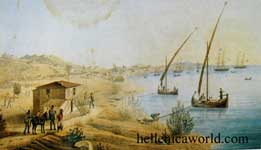
Districts of Patras
Central (Arktiko) | East | North | South
Patras neighborhoods
Agia Aikaterini | Agia Alexiotissa | Agia Sofia | Agia Triada | Agios Alexios | Agios Andreas | Agios Georgios Lagoura | Agios Dimitrios | Agios Dionysios | Agios Nektarios | Agyia | Ampelokipoi | Antheia Zarouchleikon | Anthoupoli | Aroi | Asyrmatos or Asirmatos | Begoulaki | Bozaitika | Chalkomata | Dasylio | Demenika | Diakou | Drosia | Egklykada | Eschatovouni | Evraiomnimata | Farmaki | Galaxidiotika | Geraneika | Girokomeio | Glafkos | Glaraki | Glyfada | Gouva | Ities | Kalamaki | Kaminia | Kantrianika | Kavouri | Kotroni | Koukouli | Kritika | Krya Iteon | Kypseli | Ladopoulo | Lefka | Lykochori | Makrygianni | Mantzavineika | Markato | Megoulianitika | Metamorfosi Sotiros | Neapoli Zarouchleikon | Pagona | Pantokratosa | Perivola | Pratsika | Proastio | Prosfygika | Psachou | Psarofai | Psilaolia | Pyrosvesteio | Riganokampos | Rodopoulo Zarouchleika | Skagiopouleio (Gyri) | Skagiopouleio | Skioessa | Synora | Tabachana | Taraboura | Tasi | Terpsi | Terpsithea | Tritaki | Tsivdi | Tzini | Voudi | Vryseika | Zarchouleika
Municipal districts of Patras
Ekilistra (Karya | Pournarokastro | Ryaki | Romanos) | Moira (Gotseika | Pigi) | Neo Souli (Agios Ioannis | Bintzeika | Kefalovryso | Panagia | Panagia | Patras (Balas | Charadros | Skioessa)
(* : Google Earth)
| Municipal unit Patra |
|---|
| Balas (Μπάλας, ο) |
| Patra (Πάτρα, η) |
| Skioessa (Σκιόεσσα (Βούντενη), η) |
| Charadro (Χάραδρο, το) |
References
Notes
^ "EU Commission, Directorate General for Regional Policy, Inforegio, Urban Audit, City profile".
^ Region of Western Greece: Geography - Accessed Feb. 9, 2007
^ Thomopoulos, St. N, History of the City of Patras from Antiquity to 1821, Patrai 1952, (ed. Triantafyllou, K.N.)
^ "Patras climatology data". EMY.
^ Chris K. "Hellenic Ornithological Society - Birds, birding and conservation in Greece". Ornithologiki.gr. Retrieved 2009-01-05.[dead link]
^ Patra. From antiquity until today, Kotinos A.E. Editions, Athens 2005
^ Encyclopaedia of Islam s.v. Baliabadra
^ Strategus Makrygiannis, "Memoirs", Book A, Chapter I, Athens, 1849, http://www.snhell.gr/testimonies/writer.asp?id=102
^ Triantafyllou, Κ.Ν., Historic Lexicon of Patras
^ Kounenaki Pegy, "19th Century Patras: how the character of the city changed with the development of the port after 1828" Kathimerini 14-10-01 http://news.kathimerini.gr/4dcgi/_w_articles_civ_491371_14/10/2001_3252
^ Thomopoulos
^ Region of Western Greece: Monuments - Accessed on Feb. 9, 2007
^ http://www.iiinstitute.nl/patras-restoration-and-preservation-roman-amphitheatre-patras
^ "Info about St.Andrew Church by InfoCenter Patras".
^ http://www.e-patras.gr/portal/web/common/452
^ http://www.e-patras.gr/portal/web/common/461
^ http://www.westpoint.gr/news_details.php?id=18
^ Kallikratis law Greece Ministry of Interior (Greek)
^ 1928–1980 statistical data are from: "The population of Greece in the second half of the 20th century". Hellenic Republic. National Statistical Service of Greece. Athens 1980 & "Statistical Yearbook of Greece" Hellenic Republic. National Statistical Service of Greece. Athens 1980
^ Population data from 1853 to 1920 are cited from: Kosta N. Triantafyllou, "Istorikon Lexikon ton Patron: Istoria tis poleos ton Patron apo arxaiotaton xronon eos simeron kata alphavitikin eidologikin katataksin" 3rd edition, Patrai 1995
^ Data on municipal and urban population refer to permanent population and are taken from: the "2001 Census" of the National Statistical Service of Greece
^ "ΟΛΠ - Στατιστικά στοιχεία" (in Greek). Archived from the original on 2008-04-04.
^ "Οργανισμός Λιμένος Πατρών - Το νέο λιμάνι" (in Greek).
^ "Ring Road map" (PDF).
^ "Works under construction in the region of Western Greece".
^ Loizos Bailas, Mixalis Kaplanidis. "MHXANIKH AE". Michaniki.gr. Retrieved 2009-01-05.
^ Loizos Bailas, Mixalis Kaplanidis. "MHXANIKH AE". Michaniki.gr. Retrieved 2009-01-05.
^ "Road Axis Patra - Athens - Thessaloniki - Evzoni". Hellenic Ministry of Public Works.
^ http://greece.greekreporter.com/2011/07/11/patras-new-port-in-operation/ Patras New Port
^ Loizos Bailas, Mixalis Kaplanidis. "MHXANIKH AE". Michaniki.gr. Retrieved 2009-01-05.
^ "Metropolitan Optical Network of Patras".
^ "European Culture Capital, Patras Venues".
^ "Ktizon, Presentation of the Archaeological museum of Patras".
^ "Cultural Facilities in Patras - Infocenter".
^ http://www.thebest.gr/news/index/viewStory/7985
^ "Greek Statistics Organization, Tourism data - 2006" (PDF).
^ "Greek Statistics Organization, Tourism data - 2006" (PDF).
^ "Acciona Wind Parks".
^ "Glafkos Hydroelectric Power Station".
^ aquaculture.gr/ "Andromeda Aquaculture".
^ "Nireus Aquaculture".
^ http://www.lkmk.gr/index.php?page=projects&category=1&project=0
^ "Kepenou mills".
^ "Vianex facilities in Patras".
^ "Abex Timber Manufacturing".
^ "Bytemobile - Company facts". Bytemobile.
^ "Intracom Telecom: Infrastructure". Intracom Telecom.
^ "Patras Science Park - Hosted Companies". Patras Science Park.
^ "Awards of the 7th International Venture Capital Forum" (in Greek).
^ "Industrial Systems Institute".
^ "Institute of Chemical Engineering & High Temperature Chemical Processes".
^ "Institute of Biomedical Technology".
^ a b Poetry Symposium
^ Patras Municipal Regional Theatre
^ Patras Final Report
^ Patras Future Report
^ http://www.e-patras.gr/portal/web/common/136
^ http://stadia.gr/patras/patras-gr.html
^ http://www.infocenterpatras.gr/mnimeia/mnimeia.htm
^ a b http://www.e-patras.gr/portal/web/visitors/84
^ Council of Europe (2011 [last update]). "Intercultural city: Patras, Greece". coe.int. Retrieved 22 May 2011.
^ http://www.e-patras.gr/portal/web/common/134
^ a b c d e f g "Patras Municipality - Fraternize Cities". Retrieved 4 June 2011.
^ http://www.sister-cities.org/directory/IntllistingsResults.cfm
|
Municipalities and communities of the Achaea Prefecture
Aigio | Aigira/Aegira | Akrata | Aroania | Diakopto | Dymi | Erinaios | Farres | Kalavryta | Larissos | Lefkasio | Messatida | Movri | Olenia | Paion | Paralia | Patras | Rio | Sympoliteia | Tritea | Vrachneika |
Greece :
A - B - C - D - E - F - G - H - I - J - K - L - M -
N - O - P - Q - R - S - T - U - V - W - X - Y - Z
Retrieved from "http://en.wikipedia.org/"
All text is available under the terms of the GNU Free Documentation License
| Ancient Greece
Science, Technology , Medicine , Warfare, , Biographies , Life , Cities/Places/Maps , Arts , Literature , Philosophy ,Olympics, Mythology , History , Images Medieval Greece / Byzantine Empire Science, Technology, Arts, , Warfare , Literature, Biographies, Icons, History Modern Greece Cities, Islands, Regions, Fauna/Flora ,Biographies , History , Warfare, Science/Technology, Literature, Music , Arts , Film/Actors , Sport , Fashion --- |

